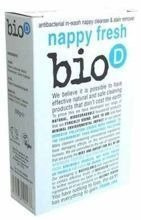How to remove grease from reusable pads and diapers
If reusable cloth diapers emit an unpleasant odor, this indicates a buildup of deposits in the diapers (these may be residues of unwashed detergents, oils, creams, and urine if the diapers were not washed thoroughly) and should be removed by stripping – a process of removing odors and deposits from diapers.
What causes diapers to become greasy?
Reusable diapers and absorbent inserts become greasy primarily from the creams and oils used on the baby's skin. As a rule, with reusable diapers, there is no need to use diaper cream frequently, because the baby's skin does not get chafed in these diapers and does not need a protective cream layer. The wipes used to clean the baby's bottom can also make the diapers greasy. Excess soap in diaper washing powders also causes greasiness, which is why it is important to choose soap-free or low-soap (less than 5%) detergents for washing diapers. The use of fabric softeners and soap nuts also causes diapers to become greasy.
How to remove grease from inserts and reusable diapers?
How can you tell when it's time to degrease inserts and reusable diapers?
- reduced absorbency of diapers;
- the insert in the pocket is dry, but the diaper has leaked anyway;
- you notice that the microfleece is not absorbing moisture into the diaper.
The first sign that it's time to degrease diapers is a loss of absorbency. You simply see that the diapers are not working – they are leaking. With greasy diapers, the insert in the pocket diaper may remain dry, but the diaper leaks. You can do a test – pour a few drops of water on the microfleece and check if the moisture is drawn into the diaper. If not, it's time to degrease. It is also worth degreasing diapers when we have received them from someone else or bought them second-hand, and then stripping them.
If the diapers have been used, wash them first.
- Knead the diapers in water with dishwashing liquid (note – choose a liquid without hand care balm). Add enough liquid to create foam. Classic green dishwashing liquid worked well for me.
- Leave the diapers covered with water and dishwashing liquid overnight.
- The next day, spin the diapers in the washing machine (800-1000 rpm) and set the rinse cycle with spin.
We already know how to degrease inserts and reusable diapers, but how can we protect diapers from getting greasy?
First of all, it is worth giving up the frequent use of diaper creams. In reusable diapers, children's skin should not get chafed, as it does in popular disposable diapers, so creams are unnecessary. If you do use something on the bottom, you can protect the inside of the diaper by using disposable liners. It's worth paying attention to what you wash diapers in. I myself use an eco-friendly eucalyptus washing powder with a simple composition and no unnecessary fillers. I must admit that we have never had a problem with greasy diapers. It is worth mentioning that diaper grease only affects synthetic materials such as microfleece, Coolmax, microfiber, and synthetic velour. Natural inserts do not need to be degreased as they do not become greasy.
Now that we have degreased the diapers, what next?
- Separate the cloth diapers from the inserts
- Soak pockets, molds, and AIOs for at least 6 hours in hot water with the addition of igienizzante buccato, nappy fresh, or mio fresh disinfectant in the amount recommended by the manufacturer, usually 1 scoop. If we want to preserve the impregnated pulp (which some companies additionally have), we can alternatively use 20 drops of lavender oil per 5 liters of water. We do not use vinegar or acid, as this can cause the elastic in the diapers to stretch. Then spin them (800-1000 rpm), set the rinse, spin and wash twice at 60°C without detergent to remove any remaining deposits.
- Soak the inserts in hot water with 4 tablespoons of citric acid for 6 hours - this will soften the inserts further. Be careful with molded diapers - in the long run, the elastic bands may stretch, so it is better to strip them in a disinfectant. Then rinse them, spin them and soak them for several hours in soda or disinfectant to neutralize the acid.
- Finally, do the same as with the pulps – set the machine to wash twice at 60 degrees without detergent. I also set a pre-wash and extra rinse to make sure that any citric acid residue is removed.
- After the stripping process has been carried out correctly, the diapers should be odor-free and there should be no foam residue in the washing machine.
Recommended

